|
The Problem with Victorian
Glassware Reproductions
by Bob Brooke
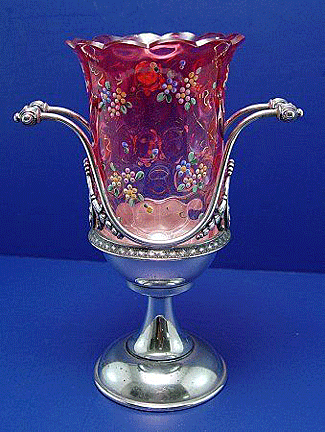 The
market demand for antique Victorian glassware has been increasing for
the last 25 years. Today, collectors have to sort through fakes,
look-alikes, reproductions and misrepresentations to find original
pieces. The
market demand for antique Victorian glassware has been increasing for
the last 25 years. Today, collectors have to sort through fakes,
look-alikes, reproductions and misrepresentations to find original
pieces.
This, in turn, has resulted in a dollar value surge due to supply and
demand. Most colored Victorian glassware is highly collectible. The
increased demand for it by collectors has caused copies to appear in
ever-growing numbers. And with authentic antique glass so difficult to
identify, it’s becoming a serious problem.
This trend seems to have begun during the 1960s and has continued until
it has reached alarming proportions today. A sea of glass confusion
confronts collectors visiting the antique shows, shops, and malls.
Today, it’s mandatory that they have the capability to visually separate
the old items from the new and not-so-new. This means that collectors
have to wade through the imitations, reissues, copies, and
reproductions.
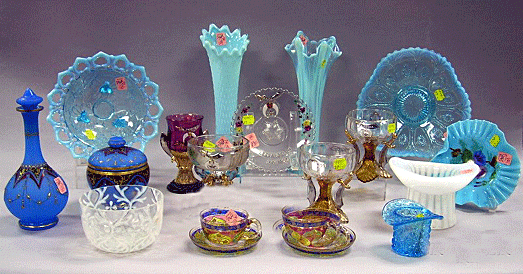
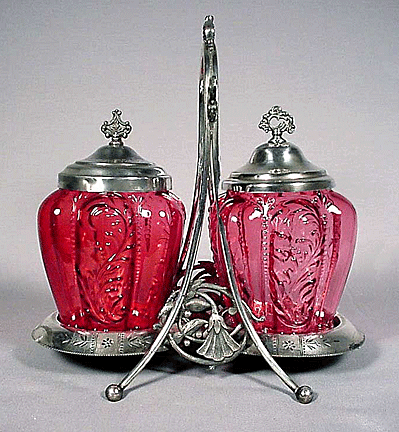 Adding
to their bewilderment is that dealers often intermingle glassware from
the 1930s through the mid-1980s with the old. Most glass collectors and
dealers aren’t specialists, so they’re vulnerable to serious buying and
selling errors. Thus, collectors must become knowledgeable of the type
of glassware they collect. This is the only way they can be assured that
when they make a purchase, it will result in the acquisition of
authentic antique pieces. Adding
to their bewilderment is that dealers often intermingle glassware from
the 1930s through the mid-1980s with the old. Most glass collectors and
dealers aren’t specialists, so they’re vulnerable to serious buying and
selling errors. Thus, collectors must become knowledgeable of the type
of glassware they collect. This is the only way they can be assured that
when they make a purchase, it will result in the acquisition of
authentic antique pieces.
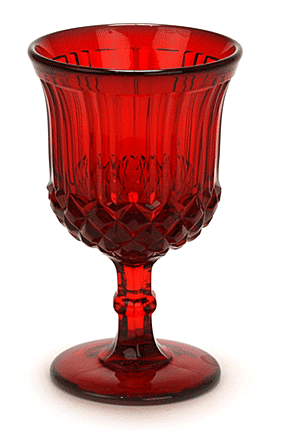 One
way for novice glass collectors to become knowledgeable quickly is to
join a national glass collector’s club. There are clubs for just about
every type of antique glass and most have local or regional chapters.
These groups promote detailed studies of their special glass category
and track and report the various reproductions and look-alikes by
listing them in newsletters sent out to their members. One
way for novice glass collectors to become knowledgeable quickly is to
join a national glass collector’s club. There are clubs for just about
every type of antique glass and most have local or regional chapters.
These groups promote detailed studies of their special glass category
and track and report the various reproductions and look-alikes by
listing them in newsletters sent out to their members.
Reproductions, copies and reissues from the 1960s and early 1970s are
having the most serious impact upon today's collectors and dealers;
particularly those folks who have entered the glassware field within the
last decade. For example, a wide variety of Victorian glass patterns has
been reproduced by the L.G. Wright Glass Company of New Martinsville,
West Virigina.
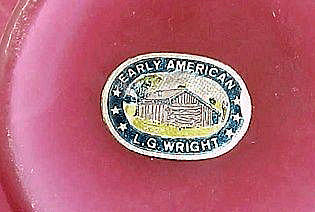 Beginning
in the late 1930s. Wright became a serious purchaser of old glass molds
from departed early American glass factories. Wright contracted with
such outstanding glass houses as Fenton, Imperial, Fostoria and
Westmoreland to reissue glass using his molds. Using his old original
molds, Wright sold the resulting wares to various dealers, jobbers, and
wholesale outlets. Many of these glass patterns ultimately found their
way into various antique shows and shops throughout the United States.
If marked at all, the glassware usually just had a paper label. Once
someone removed the label, these reproductions could be represented as
old pieces. Now that 30 to 40 years have passed, many of these
reproductions have acquired some wear, which makes identifying them as
reproductions/look-alikes of Victorian patterns even more challenging. Beginning
in the late 1930s. Wright became a serious purchaser of old glass molds
from departed early American glass factories. Wright contracted with
such outstanding glass houses as Fenton, Imperial, Fostoria and
Westmoreland to reissue glass using his molds. Using his old original
molds, Wright sold the resulting wares to various dealers, jobbers, and
wholesale outlets. Many of these glass patterns ultimately found their
way into various antique shows and shops throughout the United States.
If marked at all, the glassware usually just had a paper label. Once
someone removed the label, these reproductions could be represented as
old pieces. Now that 30 to 40 years have passed, many of these
reproductions have acquired some wear, which makes identifying them as
reproductions/look-alikes of Victorian patterns even more challenging.
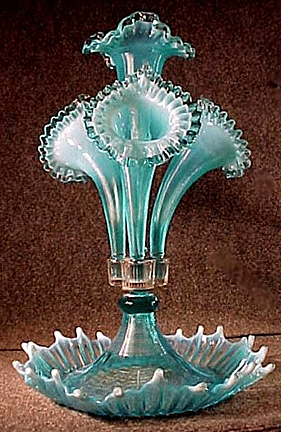 Over
the years, the importance of the LG. Wright account at Fenton was
considerable. His many contracts amounted to hundreds of thousands of
dollars involving what Fenton called private mold work" According to
Fenton factory records starting in 1959, a six year period involved ware
that was delivered to L.G. Wright from his own molds. In 1965 Fenton
produced 125 pressed glass and 140 blown forms for Wright. The pressed
ware consisted of at least 25 Daisy and Button patterns; a large
quantity of covered animal dishes and assorted goblets and compotes. The
blown ware involved lamp fonts and lamp shades in both ruby overlay and
various opalescent colors; large pitchers, milk pitchers, pickle jars,
lamp bases, tobacco jars, barber bottles, cruets, sugar shakers,
toothpicks and salt and pepper shakers. Wright died in 1969, but the
business has been continued by members of his family. Over
the years, the importance of the LG. Wright account at Fenton was
considerable. His many contracts amounted to hundreds of thousands of
dollars involving what Fenton called private mold work" According to
Fenton factory records starting in 1959, a six year period involved ware
that was delivered to L.G. Wright from his own molds. In 1965 Fenton
produced 125 pressed glass and 140 blown forms for Wright. The pressed
ware consisted of at least 25 Daisy and Button patterns; a large
quantity of covered animal dishes and assorted goblets and compotes. The
blown ware involved lamp fonts and lamp shades in both ruby overlay and
various opalescent colors; large pitchers, milk pitchers, pickle jars,
lamp bases, tobacco jars, barber bottles, cruets, sugar shakers,
toothpicks and salt and pepper shakers. Wright died in 1969, but the
business has been continued by members of his family.
While few reproductions can pass as authentic if placed side by side
with an original piece, few people have the luxury of being able to do
so. Fortunately, there are plenty of books and articles available that
have made a concerted effort to track, alert and ex-pose the existence
of many items as they appear in the antique market place. It’s well
worth the effort for novice collectors to acquire and read them because
these publications will alert them to reproduced patterns and forms.
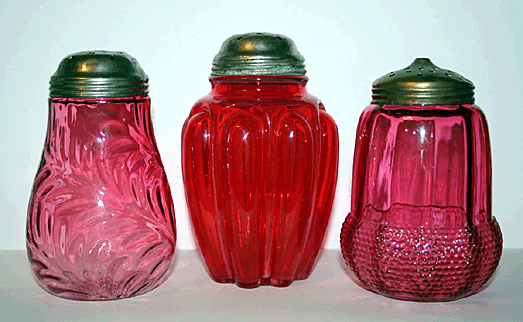
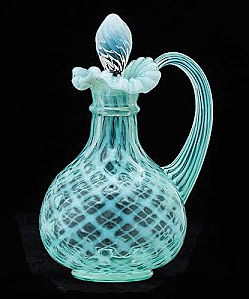 To
make sure they’re buying authentic Victorian glassware, novice
collectors need to find out in advance if the pattern of interest has
ever been reproduced and in what forms, such as cruets, master salts,
compotes, and toothpick holders. To
make sure they’re buying authentic Victorian glassware, novice
collectors need to find out in advance if the pattern of interest has
ever been reproduced and in what forms, such as cruets, master salts,
compotes, and toothpick holders.
Once they’ve done that, they need to carefully check the pattern detail
and quality. If the piece they’re interested in has been hand decorated,
some paint wear should be noticeable.
Next, they need to check for any uniform wear marks that have been
artificially created. And Upon closer inspection with a 10-power loupe,
beginning collectors need to look for signs of wear that will usually be
most prevalent on top rims and bottom of a piece. Normal wear will
appear in the form of random marks or scratches.
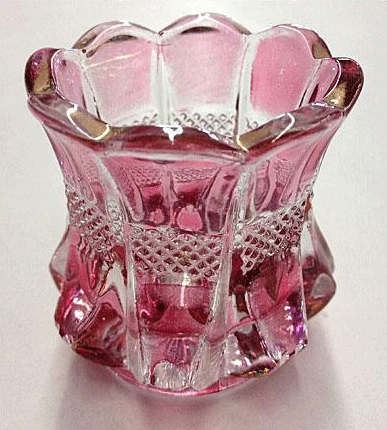 If
wear marks on a piece of Victorian glassware appear uniform, then most
likely someone created them artificially on a fake piece. This is
especially true if these marks have a frosty look to them. If
wear marks on a piece of Victorian glassware appear uniform, then most
likely someone created them artificially on a fake piece. This is
especially true if these marks have a frosty look to them.
Thickness of glass varies with age. Generally, the older a piece is, the
thicker it is, but not some Victorian pieces which were originally mold
blown. Such items as salt shakers, sugar shakers, mustard cups, and
toothpick holders in their original Victorian form have thin sides. In
the case of salt shakers and sugar shakers, the gaffer snapped them off
at the top of the pontil rod, which left fine chipping that would then
be hidden by the addition of their metal tops. Forms with thick sides
and ground-off top rims are usually reproductions and not authentic. In
the end, the old adage, “Caveat Emptor”—buyer beware–-applies.
<
Back to Antiques Extra! Archives
Next Editorial >
|
